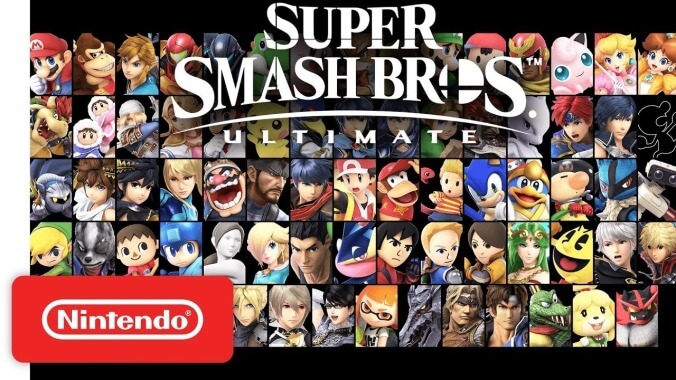Super Smash Bros. Ultimate makes you work for your fan service

Although it has merits as a serious fighting game, the Super Smash Bros. series is at its best when it’s a fun delivery system for video game nostalgia. Players choose from a bunch of different characters that are primarily drawn from Nintendo games and fight each other on a bunch of different stages that are inspired by other Nintendo games, with throwable items that are also culled from throughout the medium’s history. That is, and will always be, the core appeal of the series, but for Super Smash Bros. Ultimate, Nintendo has stepped away from simply throwing fans into a big pile of recognizable things and telling them to have fun. Instead, Ultimate is like Nintendo letting the player loose in an interactive museum, allowing them to discover the things they love at their own pace, and drip-feeding them new exhibits in the form of the very slow process of unlocking most of its 70 playable characters.
Previous entries in the Smash series delivered their biggest doses of fan service through collectible trophies, which were little virtual statues depicting characters and items from countless games from Nintendo’s long history of titles, with your accomplishments in the game coinciding with your growing collection. It was just like getting a checkmark on your report card, but the checkmarks looked like Samus from Metroid or Samurai Goroh from F-Zero—which was super fun. Ultimate ditches the trophies, but its closest approximation is a system called Spirits, which gives you special buffs in the single-player adventure mode. The Spirits are depicted with an image or concept art from their actual game, and since the developers didn’t have to put in the work of creating 3D models for trophies, it allowed them to go absurdly deep into Nintendo’s archives. For example, Ness’ absent father from EarthBound is a Spirit, as is the mahjong player from the cover of Yakuman for the Game Boy.
The brilliant twist for the Spirits, though, is that winning one for your collection requires you to beat it in a fight, but since there are more than 1,200 of them and Ultimate only has 70 characters (only 70), the developers used the game’s existing tools to create fights that are reminiscent of what these characters are. Some are straightforward, like, say, the fight for the Spirit of Solidus Snake from Metal Gear Solid 2 (you fight Solid Snake with a sword, like in his boss fight), while others cleverly twist the Smash Bros. rules.
The Excitebike Spirit, for instance, requires you to beat Wario in a fight where he only uses the attack that involves summoning a motorcycle (because Excitebike is a motorcycle game), while getting the Spirit for the ReDead enemy from The Legend Of Zelda requires the player to fight an army of Mewtwos from Pokémon that are largely invincible and spam a move that briefly freezes you in place (a nod to the terror of getting caught by a group of nearly invincible ReDeads in The Ocarina Of Time). The fight for the Spirit of Mega Man’s Dr. Light cleverly has you trying to destroy Dr. Mario (the closest available Smash character) while a raging Mega Man defends him. Those are all fun and, again, there are over a thousand of these.
One interesting difference between the Spirits and the old trophies, though, is that Ultimate isn’t very forthcoming with factual information about what games the Spirits come from. They’re divided into what “series” they originated in, whether it’s Castlevania or Sonic The Hedgehog or Mario Kart, but—unlike the trophies—it doesn’t say what specific game they originated in, or when that game came out. (A far cry from the loving—and long!—trophy descriptions that populated the museum mode in Melee.) It’s an odd choice that feels like an oversight, but the opportunity to actually engage with what a Spirit is through the lens of Super Smash Bros. is so much more useful, and a much better illustration of a game’s legacy than a list of facts. It’s a way to show gaming history rather than simply telling the player about it, and it’s done in a way that only a video game could really do. Plus, Google exists. If you want to know more about Yakuman, just look it up.
This “show don’t tell” approach also carries over into what is the only part of Super Smash Bros. Ultimate that can really be considered controversial: The aforementioned painfully slow way to unlock characters. The game starts with only the original eight from the N64 Super Smash Bros. available, with the opportunity to unlock one new character coming every 10 minutes or so. This process obviously takes a while, and it’s frustrating for players who really only want the 25 or so Fire Emblem characters (someone must like them, right?), but it also forces everyone who plays to reckon with the legacy and history of Super Smash Bros. itself by gradually introducing them to each of the 70 or so characters.
That’s an extremely fitting attitude for a game that includes every character and nearly every level from every Smash game, and it’s indicative of the absolute love for gaming and Nintendo history that Super Smash Bros. Ultimate embodies. Reading information about a game and spinning a model of a character around is one way to explore video game history, but actually playing a game is a much better way. If only more museums had wings dedicated to Pikachu and the Belmont family.